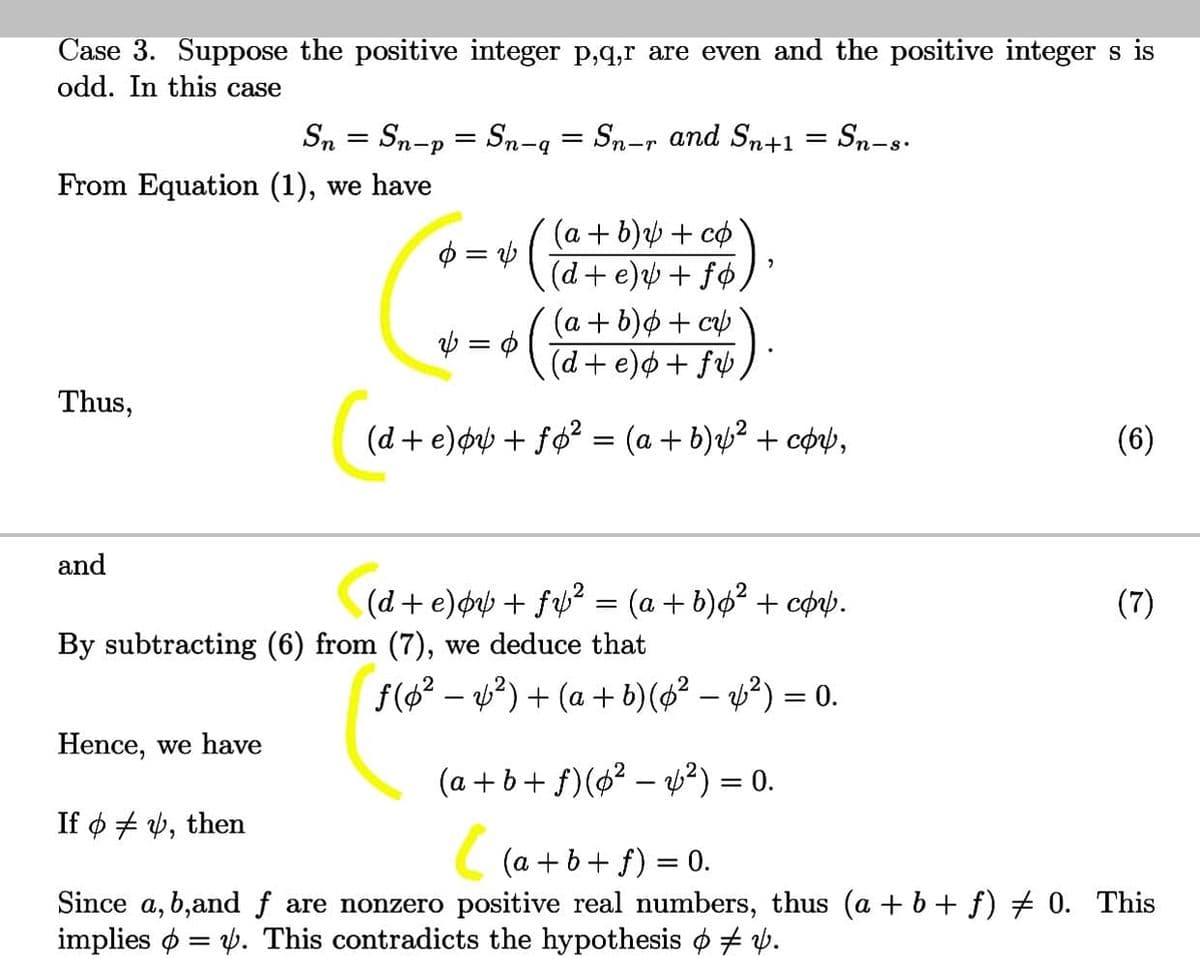Case 3. Suppose the positive integer p,q,r are even and the positive integer s is odd. In this case Sn = Sn-p = Sn-q = Sn-r and Sn+1 = Sn-s- From Equation (1), we have (a + b) + co (d+ e) + f¢, (a+b)o+cb (d+e)o+ fw, $ = b b = $ (: Thus, (d+ e)ob + fo? = (a + b)? + cop, (6) %3D and (d+ e)ob + fp? = (a + b)o? + conp. (7) By subtracting (6) from (7), we deduce that f(6? – v²) + (a + b)(4² – v²) = 0. %3D Hence, we have (a + b+ f)(6? – v²) = 0. If ø + v, then (a + b+ f) = 0. Since a, b,andf are nonzero positive real numbers, thus (a + b+ f) # 0. This %3D
Case 3. Suppose the positive integer p,q,r are even and the positive integer s is odd. In this case Sn = Sn-p = Sn-q = Sn-r and Sn+1 = Sn-s- From Equation (1), we have (a + b) + co (d+ e) + f¢, (a+b)o+cb (d+e)o+ fw, $ = b b = $ (: Thus, (d+ e)ob + fo? = (a + b)? + cop, (6) %3D and (d+ e)ob + fp? = (a + b)o? + conp. (7) By subtracting (6) from (7), we deduce that f(6? – v²) + (a + b)(4² – v²) = 0. %3D Hence, we have (a + b+ f)(6? – v²) = 0. If ø + v, then (a + b+ f) = 0. Since a, b,andf are nonzero positive real numbers, thus (a + b+ f) # 0. This %3D
Linear Algebra: A Modern Introduction
4th Edition
ISBN:9781285463247
Author:David Poole
Publisher:David Poole
Chapter2: Systems Of Linear Equations
Section2.4: Applications
Problem 32EQ
Related questions
Question
Show me the steps of determine yellow and inf is here

Transcribed Image Text:The main aim of this study is to exhibit some cases on the periodic character of
the positive solutions of the rational difference equation
aSn-q + bSn-r + cSn-s
dSn
Sn+1 = Sn-p
(1)
+ eSn-r + fSn-s ) '
-q
where a, b, c, d, e, ƒ€ (0, 0). The initial conditions S-p, S-p+1;.-,S-q, S-q+1;..,S-r,
S-r+1,...,S-s,...,S_s+1,...,S_1 and So are arbitrary positive real numbers such that
p > q > r > s > 0.
е,

Transcribed Image Text:Case 3. Suppose the positive integer p,q,r are even and the positive integer s is
odd. In this case
Sn = Sn-p = Sn-q = Sn-r and Sn+1
Sn-s.
From Equation (1), we have
$ = ( a+b)b + có
(d+ e) + fø,
(а + b)ф + сф
(d+ e)o+ f )
f = ¢
Thus,
(d + e)o + fo? = (a + b)y² + cop,
(6)
%3|
and
(d+e)ob + fv? = (a + b)o? + cop.
(7)
By subtracting (6) from (7), we deduce that
f(4? – v?) + (a + b)(? – y²) = 0.
Hence, we have
(a + b+ f)(@? – u²) = 0.
%3D
If ø + 4, then
(a + b+ f) =
= 0.
Since a, b,and f are nonzero positive real numbers, thus (a + b+ f) # 0. This
implies ø = v. This contradicts the hypothesis o + 4.
Expert Solution
This question has been solved!
Explore an expertly crafted, step-by-step solution for a thorough understanding of key concepts.
Step by step
Solved in 2 steps with 1 images

Recommended textbooks for you

Linear Algebra: A Modern Introduction
Algebra
ISBN:
9781285463247
Author:
David Poole
Publisher:
Cengage Learning

Algebra & Trigonometry with Analytic Geometry
Algebra
ISBN:
9781133382119
Author:
Swokowski
Publisher:
Cengage


Linear Algebra: A Modern Introduction
Algebra
ISBN:
9781285463247
Author:
David Poole
Publisher:
Cengage Learning

Algebra & Trigonometry with Analytic Geometry
Algebra
ISBN:
9781133382119
Author:
Swokowski
Publisher:
Cengage


Elements Of Modern Algebra
Algebra
ISBN:
9781285463230
Author:
Gilbert, Linda, Jimmie
Publisher:
Cengage Learning,

Algebra: Structure And Method, Book 1
Algebra
ISBN:
9780395977224
Author:
Richard G. Brown, Mary P. Dolciani, Robert H. Sorgenfrey, William L. Cole
Publisher:
McDougal Littell